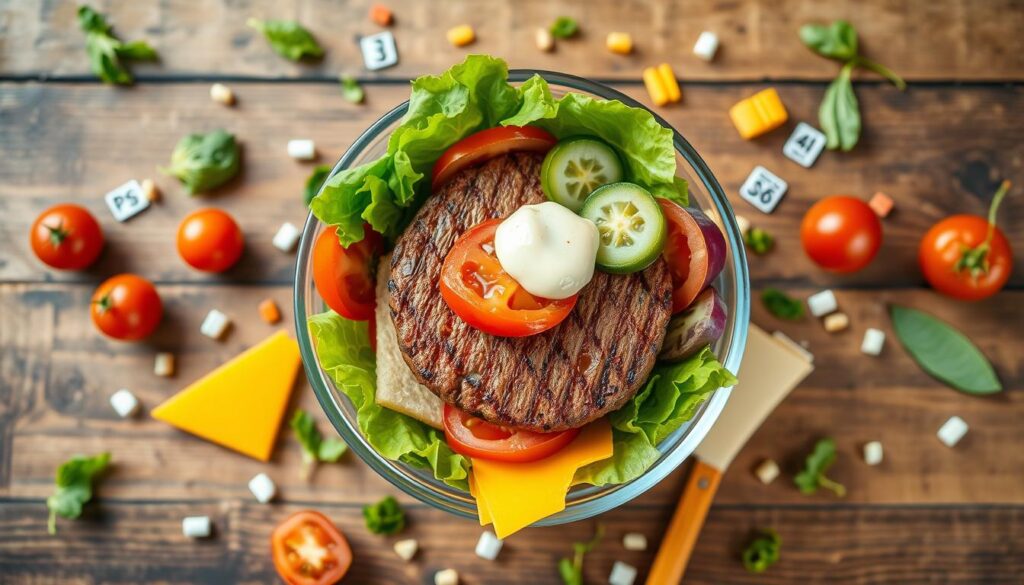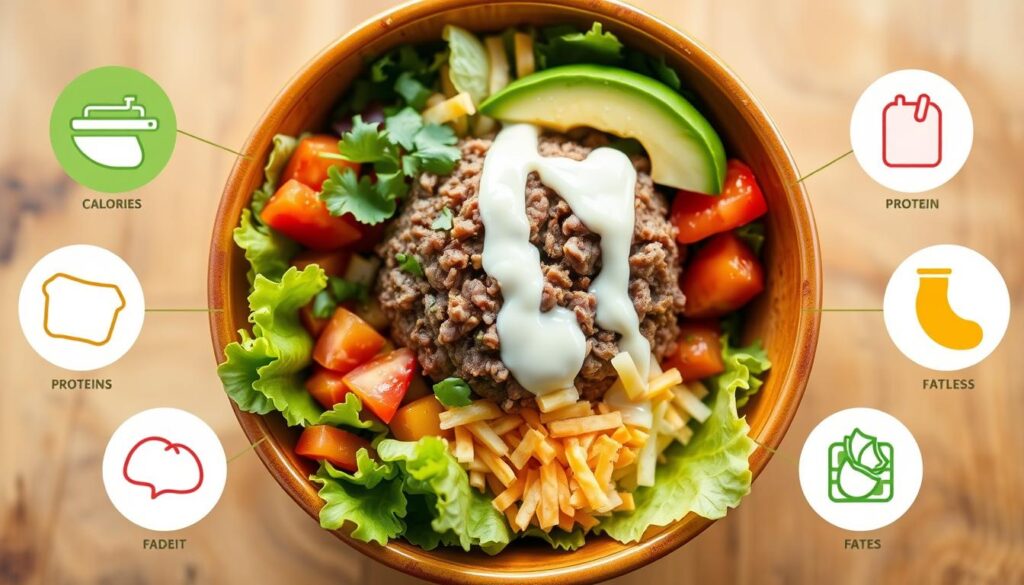Ever craved a burger but wanted something different? Burger bowls are my top pick for a unique burger taste without the bun. I love trying new foods and keeping an eye on nutrition. So, I wondered how many calories are in a burger bowl.
Burger bowls change how we enjoy our favorite foods. They turn burgers into protein-rich meals that are tasty and healthy. Knowing about burger bowl calories helps us make choices that fit our health goals.
If you’re into fitness, watching your weight, or just curious, knowing burger bowl calories is key. The calorie count can change a lot, from fast food to homemade dishes.
Key Takeaways
- Burger bowls offer a flexible alternative to traditional burgers
- Calories in a burger bowl can range widely depending on ingredients
- Homemade versions allow for better calorie control
- Protein-rich ingredients make burger bowls nutritionally dense
- Customization is key to managing burger bowl calories
What is a Burger Bowl?
Burger bowls have changed how we enjoy burgers. They turn the classic burger into a healthy, flexible meal. This fits well with today’s eating habits.

A burger bowl lets you enjoy burger flavors without the bun. It puts all the tasty burger parts into a bowl. This makes it great for those watching their nutritional intake.
Definition and Culinary Concept
A burger bowl is a burger without the bun. It has:
- Seasoned ground meat or plant-based protein
- Fresh chopped vegetables
- Savory toppings
- Signature burger-style sauces
Typical Ingredients
Burger bowls are made with many ingredients. They include:
- Protein Base: Ground beef, turkey, chicken, or plant-based alternatives
- Vegetables: Lettuce, tomatoes, onions, pickles
- Toppings: Cheese, bacon bits, avocado
- Dressings: Burger sauce, ranch, or mustard
“Burger bowls offer a creative twist on a classic meal, providing both flavor and nutritional flexibility.” – Culinary Nutrition Magazine
Burger bowls are perfect for those looking for a low-carb option. They let you enjoy burger flavors in a new way. This doesn’t mean you have to give up on taste or nutrition.
Nutritional Breakdown of a Burger Bowl
Knowing the calorie count of burger bowls is key to making smart food choices. The nutritional value of your burger bowl depends on the ingredients and how much of each you use. Let’s look at how each part adds to the total calories.

A burger bowl is made up of many ingredients that affect its calorie count. By tracking these, you can adjust your meal for better nutrition.
Calories in Common Ingredients
Each ingredient in a burger bowl has its own calorie impact. Here’s a look at what you might find:
- Ground Beef (4 oz patty): 250-300 calories
- Cheese (1 slice): 60-100 calories
- Mixed Greens: 10-20 calories
- Tomatoes: 5-10 calories
- Dressing (2 tbsp): 50-120 calories
Portion Sizes and Their Impact
The calories in a burger bowl can change a lot based on how much you eat. Eating more means more calories, while less helps keep your calorie count down.
“Portion control is key to enjoying a delicious burger bowl without excessive calories.” – Nutrition Expert
The total calories in your burger bowl can be anywhere from 350 to 700. Paying attention to portion sizes lets you enjoy a filling meal that fits your diet goals.
Average Calorie Count for a Burger Bowl
Knowing how many calories are in a burger bowl helps you make better food choices. Burger bowls are a tasty twist on traditional hamburgers. They let you enjoy classic flavors without the bun.

Factors Influencing Calorie Content
The number of calories in a burger bowl changes based on several things:
- Protein type (beef, turkey, plant-based)
- Cooking method
- Additional toppings
- Portion size
- Base ingredients
Calorie Comparison with Traditional Burgers
Burger bowls are a healthier option for those watching their calories. Here’s a look at the calorie ranges:
| Burger Type | Average Calories |
|---|---|
| Traditional Fast Food Burger | 500-750 calories |
| Standard Burger Bowl | 350-600 calories |
| Lean Protein Burger Bowl | 250-450 calories |
“A burger bowl allows you to enjoy your favorite flavors with more nutritional control.” – Nutrition Expert
To keep calories in check, pick lean proteins and fresh veggies. Also, watch your portion sizes. This way, you can make a tasty meal that fits your diet.
Pro tip: Swap high-calorie toppings for lighter ones to cut down your burger bowl’s calorie count.
Popular Burger Bowl Variations
Burger bowls have changed how we enjoy our favorite foods. They offer a healthy twist on classic meals. This makes them perfect for those looking for quick, nutritious options.
Trying different burger bowl recipes can lead to tasty, low-calorie meals. You don’t have to give up flavor or satisfaction. Here are some popular choices for various diets.
Classic Cheeseburger Bowl
The classic cheeseburger bowl keeps the flavors you love but omits the bun. It includes:
- Lean ground beef
- Shredded cheddar cheese
- Diced tomatoes
- Chopped lettuce
- Pickle slices
“A burger bowl lets you enjoy all the flavor with fewer calories!” – Nutrition Expert
Vegetarian and Vegan Options
For those who prefer plant-based meals, burger bowls have great options:
- Black Bean Bowl: Full of protein and roasted veggies
- Impossible Meat Bowl: Mimics a traditional burger with plant-based protein
- Quinoa Veggie Bowl: A nutritious, low-calorie choice
These options show that burger bowls can be both healthy and delicious. They let you tailor your meal to fit your dietary needs.
How to Customize Your Burger Bowl
Making a tasty burger bowl without too many calories is easy. Choose the right ingredients and use creative ways to make it. This way, you can enjoy a meal that’s good for you and tastes great.
Smart Ingredient Substitutions
To cut calories in your burger bowl, swap out ingredients. Here are some healthy options:
- Replace ground beef with lean ground turkey or chicken
- Use lettuce wraps instead of high-calorie buns
- Choose Greek yogurt as a creamy sauce base
- Opt for grilled proteins over fried options
Flavor-Boosting Techniques
You don’t need extra calories to make your burger bowl taste amazing. Try these zero-calorie tips:
- Fresh herbs like basil, cilantro, and parsley
- Spice blends such as paprika, cumin, and garlic powder
- Citrus zest for bright, tangy notes
- Vinegar-based hot sauces
“Eating healthy doesn’t mean eating bland – it’s about making smart, flavorful choices.” – Nutrition Expert
Portion Control Strategies
Controlling portion sizes is key to eating less. Use smaller plates, measure ingredients, and pick nutrient-rich foods. This way, you’ll enjoy a filling burger bowl that’s good for you.
Nutritional Benefits of Burger Bowls
Burger bowls are more than tasty meals. They are packed with nutrients that boost your health. Knowing the nutritional facts helps you choose better foods.
Looking into burger bowl nutrition shows many health benefits. Unlike regular burgers, these bowls offer a balanced diet. This maximizes nutritional value.
Rich in Protein and Fiber
Protein is key in burger bowls. You can get 20-30 grams of protein per serving. This is great for:
- Muscle recovery
- Sustained energy
- Appetite control
Fiber in burger bowls also aids digestion. Lettuce, tomatoes, and whole grains help meet your fiber needs.
Vitamins and Minerals in Common Ingredients
Burger bowls have a variety of nutrients. Here’s a look at some important vitamins and minerals:
| Ingredient | Key Nutrients | Health Benefits |
|---|---|---|
| Ground Beef | Iron, Zinc, Vitamin B12 | Blood health, immune support |
| Lettuce | Vitamin A, Vitamin K | Eye health, bone strength |
| Tomatoes | Vitamin C, Lycopene | Antioxidant protection |
“Burger bowls transform a classic comfort food into a nutrient-dense meal that supports your wellness goals.” – Nutrition Expert
By picking the right ingredients, you can make a burger bowl that’s both tasty and nutritious. It’s a great way to get the nutrients you need for good health.
Are Burger Bowls a Healthy Choice?
Finding healthy fast food can be tough. Burger bowls are a good option for those watching calories. They offer a mix of nutrition and taste.
Thinking about burger bowls as a healthy meal involves several factors. Your diet goals and health needs will decide if they’re right for you.
Balancing Calories with Nutritional Value
Burger bowls can be made to be nutritious. It’s all about choosing the right ingredients. This way, you get lots of nutrients without too many calories.
- Select lean protein sources like grilled chicken or turkey
- Include plenty of fresh vegetables
- Choose whole grain or cauliflower base options
- Limit high-calorie toppings and dressings
Considerations for Specific Diets
Many diets can include burger bowls with a few tweaks:
| Diet Type | Recommended Modifications |
|---|---|
| Keto | Use lettuce base, add high-fat toppings |
| Vegetarian | Replace meat with plant-based protein |
| Low-Carb | Eliminate bread, focus on protein and vegetables |
“Burger bowls offer a versatile canvas for creating nutritious meals that align with your health goals.” – Nutrition Expert
Remember, controlling portions and choosing quality ingredients is key. With careful choices, a burger bowl can be a healthy and tasty meal.
Fast Food vs. Homemade Burger Bowls
When looking at burger bowl options, knowing the calorie content is key. This helps you make better food choices. The difference between what you get at a restaurant and making it at home matters a lot.
Fast food places often have high-calorie items that can harm your health goals. Let’s look at the nutrition of burger bowls in different places.
Calorie Counts in Fast Food Chains
Popular fast food spots offer burger bowls with different calorie counts:
| Restaurant | Burger Bowl Calories | Average Protein |
|---|---|---|
| McDonald’s | 450-600 calories | 25-30g |
| Wendy’s | 500-650 calories | 30-35g |
| Five Guys | 600-800 calories | 35-40g |
Making Healthier Choices at Home
Making burger bowls at home lets you pick what goes in. This way, you can eat less calories. Here are tips for healthier bowls:
- Use lean ground meat or plant-based protein
- Add more vegetables for volume and nutrition
- Control portion sizes
- Choose low-fat cheese and dressings
“Your kitchen is the best restaurant for nutritional control” – Nutrition Experts
By knowing about fast food calories and cooking smart, you can enjoy tasty burger bowls. You won’t have to give up on your health goals.
Tips for Calorie Conscious Eating
It can be tough to eat calories wisely, especially with tasty burger bowls. Knowing how to pick your meals helps keep your diet balanced and flavorful.
Smart eating begins with knowledge and making smart choices. The secret to eating calories wisely is to understand nutrition labels and control how much you eat.
Mastering Nutrition Labels
It’s important to read ingredient lists and nutrition labels well. This helps manage burger bowl calories. Here’s what to focus on:
- Check serving sizes carefully
- Review total calorie content
- Examine protein and fat percentages
- Look for hidden sugars and additives
Portion Control Strategies
Keeping your portions in check can really cut down on calories. Here are some tips for managing burger bowl servings:
- Use smaller plates to reduce portion sizes
- Measure ingredients before cooking
- Practice mindful eating techniques
- Balance high-calorie ingredients with vegetables
| Ingredient | Calories | Portion Control Tip |
|---|---|---|
| Ground Beef (Lean) | 150-200 calories/4 oz | Use 3 oz instead of 4 oz |
| Cheese | 100-110 calories/oz | Choose low-fat options |
| Avocado | 320 calories/whole | Limit to 1/4 serving |
“Eating mindfully isn’t about restriction, it’s about making informed choices that nourish your body.”
By using these tips, you can enjoy yummy burger bowls and stay healthy.
Frequently Asked Questions about Burger Bowls
Burger bowls are a hit with health-conscious eaters looking for tasty, flexible meals. They offer a great alternative to traditional burgers. Knowing more about them can help you make better food choices.
Are Burger Bowls Gluten-Free?
Not every burger bowl is gluten-free. The gluten content varies based on the ingredients used. When counting calories in a burger bowl, remember to check for gluten:
- Breadcrumbs in meat mixture
- Sauces with wheat-based thickeners
- Processed meat additives
To make a gluten-free burger bowl, pick:
- Grass-fed ground meat
- Fresh vegetables
- Gluten-free condiments
How to Make a Low-Calorie Version
For low-calorie burger bowls, swap out ingredients wisely. Here are some tips:
| Ingredient | Calorie Reduction Strategy | Estimated Calories Saved |
|---|---|---|
| Beef | Lean ground turkey | 50-100 calories per serving |
| Cheese | Low-fat cheese | 30-50 calories per serving |
| Dressing | Greek yogurt base | 40-60 calories per serving |
Pro tip: Control your portions and choose nutrient-rich ingredients. This way, you can enjoy a delicious, low-calorie burger bowl.
“Eating smart doesn’t mean eating bland – it’s about making informed choices.” – Nutrition Expert
Conclusion: Making the Most of Your Burger Bowl
Burger bowls are a fun and healthy way to enjoy your favorite tastes. They let you control the nutritional info and calorie count. This way, you can make a meal that’s tasty and good for you.
Finding Balance in Calories and Nutrition
When making burger bowls, pick your ingredients wisely and watch your portions. Use lean proteins, fresh veggies, and choose toppings carefully. This turns a high-calorie meal into a healthy choice.
Try using lettuce as a base, pick grilled meats, and add colorful veggies. This boosts the nutritional value of your bowl.
Enjoying Burger Bowls in a Healthy Lifestyle
Enjoying food is all about balance and moderation. Burger bowls can be a great part of a healthy diet if you make them right. Try new ingredients, keep track of your portions, and listen to what your body needs.
With smart choices, you can enjoy a tasty burger bowl that fits your health goals. Your food journey is full of possibilities for tasty, healthy meals.

